Article
Is the Steam shop the best it can be?
- March 10, 2022
- Updated: March 7, 2024 at 4:52 PM
The Steam shop and Steam games platform is known for epic steam sales, the Valve Steam Deck, supporting indie game developers, and much more. It’s been around since 2003, making it almost 20 years old now.
Though other developer-specific storefronts like EA Play, Uplay, and others exist, Steam offers games from thousands of developers at all price points — consistently offering sales and user-created mods. The problem is that they are no longer the only player in the digital games storefront game. Rivals like Epic Games have forced Steam to re-examine its features, offerings, pricing structure, developer tools, and more.
How does the Steam platform stack up to rivals and what are the problems users have found? Let’s explore the Steam shop from things like the Steam shop, Steam games, and Steam wallet to skins gambling and anti-competitive practices.
Steam platform creator: Valve and Gabe Newell
Gabe Newell and Mike Harrington, two former Microsoft employees, started the company Valve Software/Valve Corporation in 1996. Though initially developing video games, the company developed its digital storefront known as Steam in 2002. It only offered first-party Valve games at first but began to more widely distribute other games starting in 2007.
Over the course of its lifetime, Steam has added new and developed unique features, and worked alongside its development arm (Valve). It accommodates Windows, macOS, Linux, mobile platforms, and virtual reality options. In fact, Valve produced Half-Life: Alyx in 2020 — a game designed for VR.
Though the platform offers many features, many users just use it as a video game digital storefront and library.
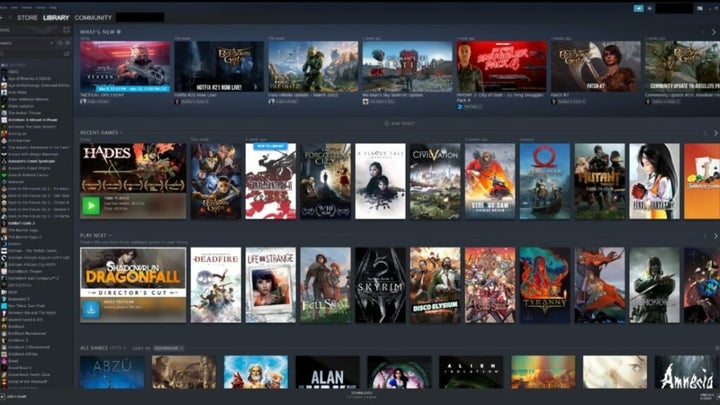
Organization, UI, and features
Having changed to keep up with popular UI and UX design, the Steam interface now focuses on image-heavy organization. This keeps things very vibrant with lots of visual information, but may not be for everyone. However, Steam also has lots of quality-of-life features such as:
- Friends list that shows what games friends are playing, offers you to join or invite, etc.
- A community hub for game discussions, workshop mods, and more.
- A digital store front where users can search, find, and learn more about different titles.
- A more secure Steam Wallet.
- The “Steam Points Shop” where users can buy game-specfic emotes, profile skins, digital stickers, and more.
- A somewhat bizarre, but still active trading card market where users earn cards by playing games and then sell them to other users for “gems” or real currency to use for their Steam Wallet
- Game achievement and play time tracking.
- Community broadcasts from users and developers alike.
Overall, the UI is very useable and the organization makes tons of sense. Since Valve has had years to refine it using market research, developer input, and user feedback, Steam follows in the same fashion and has well-thought-out UI and UX design.

Developer tools and features
Though not many developers are pleased that Valve pockets 30% of every sale on its platform, the Steam shop has tried to do more for developers in the last few years. This includes making their developer tools more robust and incorporating more initiatives such as SteamVR.
Steamworks
This API gives studios publishing and development tools for free that better allow them to use Steam features. It helps with microtransactions, matchmaking, Steam Workshop, DDoS protection, achievements, screenshots, cloud saves, and more.
The program has become so thorough over the years that Steam has tons of documentation for developers to scour through.
Steam workshop
Users with Steam accounts can create content for video games owned on the Steam platform. Other players can easily subscribe to these mods with one click, curate mod collections for specific uses, and more.
It originally came about to distribute Team Fortress 2 items then redesigned to accommodate more titles and more robust use cases. Some creators were even compensated for their work as it was incorporated into the base game.
Games like Cities: Skylines and Valve’s own Half-Life depend heavily on mod support.
SteamVR
This software and hardware platform works alongside VR technology such as the Valve Index and HTC Vive. It uses positional tracking base stations to facilitate room-scale experiences. This means that users can move within a space as opposed to standing in one place.
Though still available for Linux and Windows, Valve no longer offers SteamVR macOS support as of 2020.
Steam Direct
Steam Greenlight was released in 2012 with a focus on making it easier for Indie developers to reach potential users. However, the initiative did not go as planned and was replaced by Steam Direct in 2017.
It lets potential developers distribute their product on Steam by completing the required forms and paying an application fee that they can recoup later. If a game exceeds $1,000 USD in sales, Valve pays back the developer but some still feel this process doesn’t work. Raw Fury and Fig offer to pay the fee for some developers if they can’t pay.
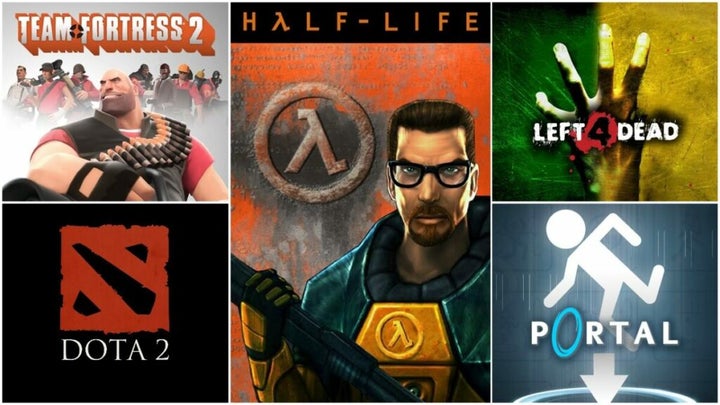
First party Steam games
Valve started out producing video games, so Steam maintains certain first-party titles including:
- Half-Life franchise
- Team Fortress franchise
- Dota 2 (Defense of the Ancients)
- Counter-Strike including CS: GO
- Portal franchise
- Left 4 Dead franchise
- Garry’s Mod
Most recently, the company released Aperture Desk Job, a short experience set in the Portal universe, for free on March 1, 2022. It served as a tech demo for the new Steam Deck hand-held device from Valve.
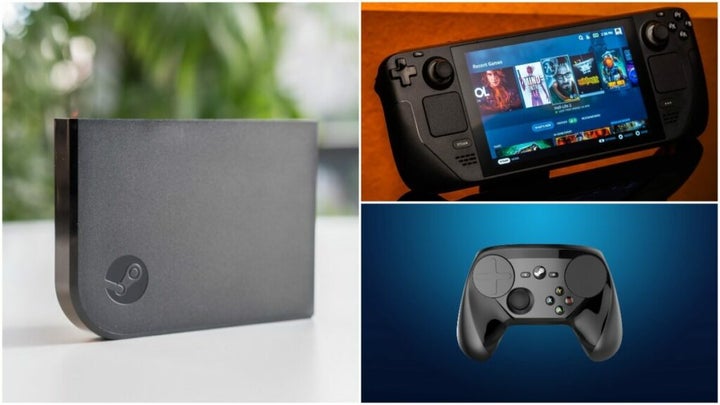
Proprietary hardware
Valve has pursued several hardware ventures in their lifetime with some being more successful than others. The recently released Steam Deck has received middling reviews so far since certain huge games such as Destiny 2 or Fortnite are not supported on it. In fact, users trying to bypass this are getting banned.
To date, Valve has created these hardware platforms for Steam:
- Steam Machine – a SteamOS powered hardware device for gaming that ultimately did not become popular, but led to the Steam Link — an at-home streaming technology now embedded on many Samsung televisions
- Steam Controller – a proprietary controller designed for use with the Steam Machine that also works with the Steam Link
- Steam Deck – a handheld device intended to run available Steam games

Problems and sticking points of the Steam shop
Every software has its issues and bugs and Steam is no exception to this. Some bugs involved hacking into PCs while others let users download any game for free (briefly in 2018). But not all problems are software-related with Steam.
Here are some of the notable problems experienced by users and developers when it comes to operating on and using the Steam shop.
Limited user support
Since Steam acts as a “middleman” of sorts, it doesn’t offer as robust user support as some people might think. If a player encounters a problem with a game such as a crash, they’ll have to go to the game developer for help. If a Steam user loses their password, they’ll have to go through Valve instead.
However, some things go further with game developers having dedicated Steam support pages on their websites like Facepunch Studios, developers of the game Rust.
Confusing and limited refunds
Valve incorporated refunds into their system in 2015 but users still struggle with understanding how they work. Users can get refunds if the following criteria are met:
- You have NOT played the game for more than 2 hours
- You’ve purchased the game less than 14 days ago
Unfortunately, if you don’t meet those criteria, Steam will likely reject your refund application.
This also backfired for developers as people would buy a game just to review bomb it, then get a refund without even playing the game. Steam tried to mitigate this by putting whether or not a game was refunded in game reviews for other users to see.
How much devs make from Steam sales
Developers have more options now when it comes to how they want to distribute their games. Rivals to Steam like Itch.io let them offer it for just a 10% cut by default compared to Steam’s industry standard of taking a 30% cut from every sale. Epic Games gives developers 88% of every sale.
But some developers don’t believe that Steam offers enough to justify taking this much from every sale.
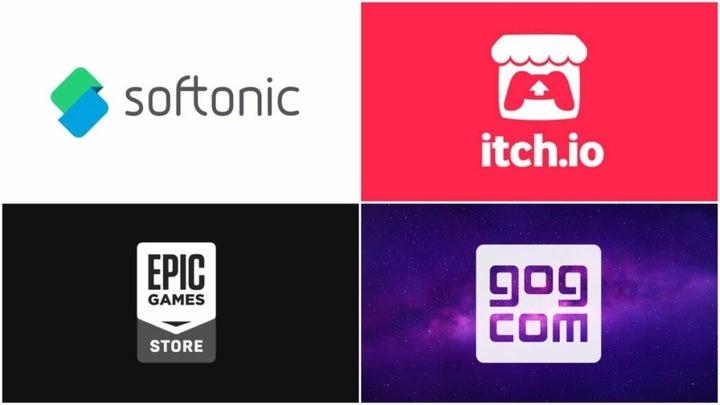
Rivals and competitors vs. Steam shop
As with everything, the digital Steam shop has plenty of competitors no matter how many amazing Steam sales they have. In fact, Steam misses out on certain game launches due to these rivals with companies like Amazon even eating into Steam sales.
Epic Games
As a software developer and game development studio, Epic Games has a huge leg up on Valve and Steam thanks to its use of Unreal Engine 5 — an engine used by many other game developers. The storefront also enters into timed-exclusivity deals with developers to maintain a monopoly for a certain window of time.
The company might be best known for Fortnite and occasionally giving away entire Triple-A game titles for free including the entire Tomb Raider reboot trilogy in 2021.
However, Epic Games lacks a workshop for mods like Steam has and the UI may not be as intuitive. But Epic Games has stated that mods are in Beta as of 2020.
Good Old Games (GOG)
CD Projekt, known for Cyberpunk 2077 and The Witcher, owns this subsidiary now known as GOG.com. It acts as a digital distribution platform that gives users DRM-free games using Linux, macOS, and Windows. It also supports DRM-free video in multiple resolutions to accommodate reduced download quotas or bandwidth speeds.
Being a smaller storefront, it offers fewer Triple-A titles but more Indie titles and lacks a workshop hub. While GOG does allow more mods and does not lock you into its platform, it does not have as simple an interface with a one-click “Subscribe” option for mods.
Softonic
Having got its start as a file-oriented download platform and service, Softonic has grown since its 1996 founding to include many different kinds of software. It offers VPNs, browsers, Minecraft, Cash App, Microsoft Excel, Netflix, iTunes, and more.
Finding mobile games is much easier using Softonic than using Steam. For those looking to go around an app store, Softonic is a great alternative. But for those who want a console or PC competitor, Softonic may fall short of Steam.
Xbox Game Pass
Since Microsoft acquired Activision/Blizzard recently, Xbox Games Pass may become more competitive against other digital storefronts. The big difference here is that Xbox can offer users a subscription service for a monthly fee where Steam allows users to own the digital property outright.
For those looking for user-created content or a wider range of games, Steam is still the way to go.
Itch.io
Users looking for indie games, free games, or user-created content can count on Itch.io for just that. The storefront offers wild bundles such as 992 for just $10 USD, but users can also find comics, books, physical games, soundtracks, and even game assets on Itch.io.
Founded in 2013, the Indie platform also hosts game jams — events that let participants create their own games over the course of 1 to 3 days. Contrary to Steam taking 30% of sales, Itch.io only takes 10% from each sale by default. The site also allows users to pay for free games if they wish to do so.
For Indie titles and other content, Itch.io is great, but Steam takes the cake when it comes to Triple-A content.
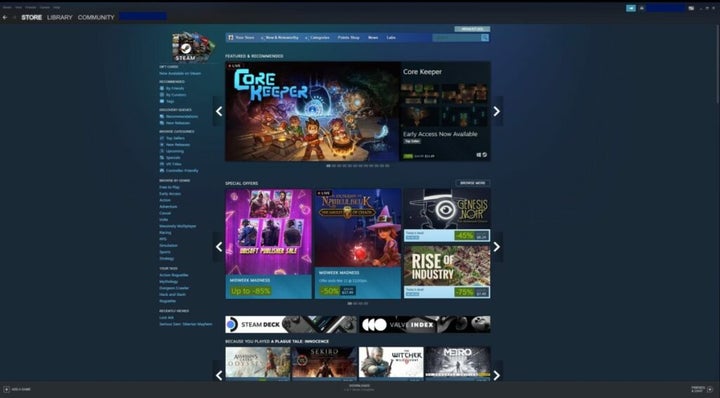
Verdict on Steam shop
It’s difficult not to recommend Steam due to the limited availability of such robust digital games storefronts. Epic Games and GOG do offer very similar experiences, but Steam is the oldest player in this market with the most history, research data, and features.
As a result, it is very effective at offering a digital storefront and library for lots of different kinds of video games.
PROS
- Exceptionally large number of games offered
- Visual and intuitive UI design
- Video streaming
- Compatible with Steam Link and Steam Deck
- Big Picture mode for larger screens
- Lots of free developer tools
- Provides some software and film content as well as a music player
- Remote play and downloads
- Extra in-platform features such as a card trading market, Steam points shop, and discovery queue
CONS
- Takes 30% of sales from developers
- Platform-locked mods
- Limited support for users
- Lacks built-in video-capture tools
- Potentially overwhelming interface
- Occasional pop-ups of inappropriate games on the home page or discover queue
- No physical game copies
- Tricky and limited-time refund process
Latest from Juliet Childers
You may also like
- News
A Day in the Life of a Modern SMB Powered by Google Workspace
Read more
- News
After fighting for it, the fans have succeeded and Dying Light: The Beast has listened to them
Read more
- News
This game has excited and sold more than three million copies in just three days
Read more
- News
Star Trek: Strange New Worlds premieres its third season, but some creative ideas were left behind
Read more
- News
Look at the impressive transformation of Minecraft with this update
Read more
- News
He participated in one of the most iconic series on television, and he also had to fight for equal pay
Read more
